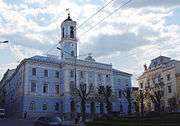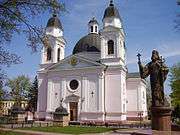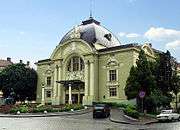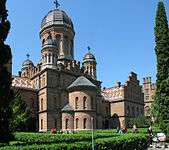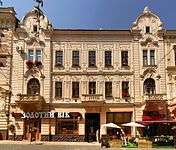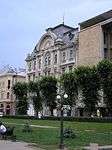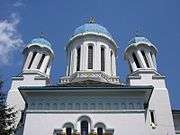Chernivtsi
| Chernivtsi Чернівці (Ukrainian) Cernăuți (Romanian) | |||
|---|---|---|---|
|
| |||
| |||
| Nickname(s): "Little Vienna"[1][2] | |||
.png) The Chernivtsi City Municipality (center) on the map of Chernivtsi Oblast. | |||
 Chernivtsi Location of Chernivtsi in Ukraine | |||
| Coordinates: 48°18′0″N 25°56′0″E / 48.30000°N 25.93333°ECoordinates: 48°18′0″N 25°56′0″E / 48.30000°N 25.93333°E | |||
| Country |
| ||
| Oblast | Chernivtsi Oblast | ||
| Municipality | Chernivtsi Municipality | ||
| First mentioned | 1408 | ||
| City rights | 14th century | ||
| Subdivisions |
| ||
| Government | |||
| • Mayor | Oleksiy Kaspruk (independent)[3] | ||
| Area | |||
| • City | 153 km2 (59 sq mi) | ||
| Elevation | 248 m (814 ft) | ||
| Population (2014) | |||
| • City | 263,287 | ||
| • Density | 1,700/km2 (4,500/sq mi) | ||
| • Metro | 723,100 | ||
| Time zone | EET (UTC+2) | ||
| • Summer (DST) | EEST (UTC+3) | ||
| Postal code | 58000 | ||
| Area code(s) | +380 372 | ||
| Vehicle registration | CE/26 | ||
| Sister cities | Salt Lake City, Konin, Suceava, Nazareth Illit, Saskatoon, Klagenfurt, Podolsk | ||
| Website | www.chernivtsy.eu | ||
Chernivtsi (Ukrainian: Чернівці́, Černivci [t͡ʃɛrniu̯ˈt͡sʲi], Romanian: Cernăuți [tʃerˈnəutsʲ]; Yiddish: טשערנאָוויץ Tschernowitz; see also other names) is a city in western Ukraine, situated on the upper course of the River Prut. Chernivtsi is the administrative center of Chernivtsi Oblast (province) – the northern, Ukrainian part of the historical Moldavian region of Bukovina. At the time of the 2001 Ukrainian Census, the population of the city was 240,600.[4]
Chernivtsi is currently viewed as one of Western Ukraine's main cultural centers. The city is also considered one of Ukraine's important educational and architectural sites. Historically a cosmopolitan community, Chernivtsi was once dubbed "Little Vienna"[1][2] and "Jerusalem upon the Prut". Chernivtsi is currently twinned with seven other cities around the world. The city is a major regional rail and road transportation hub, also housing an international airport.
Name
Aside from its Ukrainian name of Chernivtsi, the city is also known by several different names in various languages, which still are used by the respective population groups much as they used to be throughout the city's history, either in connection with the rule by one country or another or independently from it: Romanian: Cernăuți; German: Czernowitz; Polish: Czerniowce; Hungarian: Csernovic, Russian: Черновцы́, translit. Chernovtsy (until 1944: Чернови́цы, translit. Chernovitsy). In the times of Halych-Volyn Principality the city's name was Chern.
History

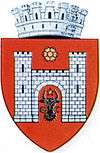
Archeological evidence discovered in the area surrounding Chernivtsi indicates that a population inhabited it since the Neolithic era. Later settlements included those of the Cucuteni-Trypillian culture,[5] the Corded Ware culture; artifacts from the Bronze and Iron Ages were also found in the city.
A fortified settlement located on the left (north-eastern) shore of the Prut dates back to the time of the Principality of Halych and is thought to have been built by Grand Prince Yaroslav Osmomysl.[6] Legendary accounts refer to this fortress-city as Chern', or Black city; it is said to owe its name to the black color of the city walls, built from dark oak layered with local black-colored soil.[7] This early stronghold was destroyed during the Mongol invasion of Europe by Boroldai in 1259. However, the remaining ramparts of the fortress were still used for defense purposes; in the 17th century they were augmented with several bastions, one of which is still extant.
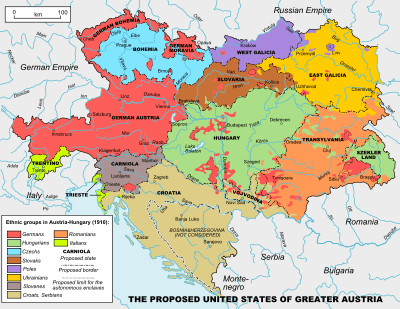
Following the destruction of the fortress, later settlements in the area centered on the right (south-western) shore of the Prut River, at a more strategically advantageous, elevated location. In 1325, when Kingdom of Poland seized control of Galicia, and came into contact with the early Vlach (Romanian) feudal formations, a fort was mentioned under the name Țețina; it was defending the ford and crossing point on the Prut River. It was part of a group of three fortifications, the other two being the fortress of Hotin on the Dniester to the east, and a fort on the Kolachin River, an upriver tributary of Prut.
Between 1359 and 1775, the city and its surroundings were part of the Principality of Moldavia, one of the historic provinces of Romania; the city being the administrative center of the homonymous ţinut (county).[8] The name Cernăuţi/Chernivtsi is first attested in a document by Alexandru cel Bun (Alexander the Good) on 8 October 1408.[9] In Ottoman sources, the city was mentioned as "Çernovi", a phonetic transliteration of a Latin cognomen meaning new castle see French Castelnau[10] or Welsh Carno.
In 1775, the northwestern part of the territory of Moldavia was annexed by the Habsburg Empire; this region became known as Bukovina. The city became the region's capital, which in 1849 was raised in status and became known as the Duchy of Bukovina, a crownland of the Austrian Empire. The city received Magdeburg rights.[11] The city began to flourish in 1778 when Knight Karl von Enzenberg was appointed the chief of the Military Administration. He invited many merchants, craftsmen and entrepreneurs to help develop trade and other businesses. Saint Peter's Fairs ( 1–15 July) had given a new vibrant impulse to the market development from 1786. In the late 19th century the German language—due to the Habsburgian and the very important Jewish influence—became the lingua franca and more and more newspapers were edited in German, also a remarkable literary production in German began in this period, featuring most prominently Karl Emil Franzos.[12]
During the 19th and early 20th century, Chernivtsi became a center of both Romanian and Ukrainian national movements. In 1908, it was the site of the first Yiddish language conference, the Czernowitz Conference, coordinated by Nathan Birnbaum. When Austria-Hungary dissolved in 1918, the city and its surrounding area became part of the Kingdom of Romania.[13] In 1930, the city reached a population of 112,400: 26.8% Jews, 23.2% Romanians, 20.8% Germans, 18.6% Ukrainians, the remainder Poles and others. It was one of the five university centers of interwar Romania.
In 1940, the Red Army occupied the area; the area around the city became known as Chernivtsi Oblast, and was allotted to the Ukrainian SSR by the Soviet Union.[13] The city's large Romanian intelligentsia found refuge in Romania; while the Bukovina Germans were "repatriated" according to a Soviet-Nazi agreement. Under the regime of military dictator Ion Antonescu, Romania had switched from an ally of France and Britain to one of Nazi Germany; subsequently, in July 1941, the Romanian Army retook the city as part of the Axis attack on the Soviet Union during World War II. In August 1941, Romanian military dictator Ion Antonescu ordered the creation of a ghetto in the lowland part of the city, where 50,000 Bukovina Jews were crammed, two-thirds of whom would be deported to Transnistria in October 1941 and partly in early 1942, where the majority perished. Romanian mayor of the city Traian Popovici managed to persuade Antonescu to raise the number of Jews exempted from deportation from 200 to 20,000.
In 1944, when Axis forces were driven out by the Red Army, the city was reincorporated into the Ukrainian SSR. Over the following years, most of the Jews left for Israel; the city was an important node in the Berihah network. Bukovina Poles were also "repatriated" by the Soviets after World War II. The city became a predominantly Ukrainian one.
Since 1991, Chernitvtsi has been a part of independent Ukraine. In May 1999, Romania opened a consulate general in the city. Contemporary Chernivtsi is an important regional center, which is situated on the picturesque banks of the Prut River and occupies an area of about 150 square kilometres (58 sq mi).
In April 2016, amidst the Ukraine crisis, the Chernitvtsi city council banned the use of the word "Russia" on signboards, advertisements, billboards, tables and other public boards.[14]
Geography and climate
Chernivtsi is located in the historic region of Bukovina, which is currently shared between Romania (south) and Ukraine (north). The city lies 248 meters above sea level, and is surrounded by forests and fields. The River Prut runs through the city's landscape.
| Climate data for Chernivtsi | |||||||||||||
|---|---|---|---|---|---|---|---|---|---|---|---|---|---|
| Month | Jan | Feb | Mar | Apr | May | Jun | Jul | Aug | Sep | Oct | Nov | Dec | Year |
| Record high °C (°F) | 15.3 (59.5) |
21.3 (70.3) |
24.6 (76.3) |
30.9 (87.6) |
33.5 (92.3) |
35.6 (96.1) |
37.4 (99.3) |
37.7 (99.9) |
36.3 (97.3) |
31.0 (87.8) |
24.9 (76.8) |
17.9 (64.2) |
37.7 (99.9) |
| Average high °C (°F) | 0.1 (32.2) |
1.7 (35.1) |
7.2 (45) |
14.5 (58.1) |
20.4 (68.7) |
23.1 (73.6) |
25.1 (77.2) |
24.6 (76.3) |
19.6 (67.3) |
13.8 (56.8) |
6.1 (43) |
0.9 (33.6) |
13.1 (55.6) |
| Daily mean °C (°F) | −2.9 (26.8) |
−1.8 (28.8) |
2.7 (36.9) |
9.2 (48.6) |
14.9 (58.8) |
18.0 (64.4) |
19.8 (67.6) |
19.1 (66.4) |
14.3 (57.7) |
8.8 (47.8) |
2.6 (36.7) |
−1.9 (28.6) |
8.6 (47.5) |
| Average low °C (°F) | −5.7 (21.7) |
−4.7 (23.5) |
−0.9 (30.4) |
4.6 (40.3) |
9.8 (49.6) |
13.3 (55.9) |
15.1 (59.2) |
14.4 (57.9) |
9.9 (49.8) |
4.9 (40.8) |
−0.2 (31.6) |
−4.4 (24.1) |
4.7 (40.5) |
| Record low °C (°F) | −30.7 (−23.3) |
−29.0 (−20.2) |
−20.7 (−5.3) |
−13.6 (7.5) |
−2.0 (28.4) |
3.0 (37.4) |
7.4 (45.3) |
3.4 (38.1) |
−4.4 (24.1) |
−9.7 (14.5) |
−17.5 (0.5) |
−28.0 (−18.4) |
−30.7 (−23.3) |
| Average precipitation mm (inches) | 26 (1.02) |
30 (1.18) |
32 (1.26) |
47 (1.85) |
76 (2.99) |
88 (3.46) |
98 (3.86) |
77 (3.03) |
49 (1.93) |
37 (1.46) |
31 (1.22) |
33 (1.3) |
624 (24.57) |
| Average rainy days | 7 | 7 | 12 | 17 | 17 | 18 | 15 | 13 | 13 | 13 | 12 | 9 | 153 |
| Average snowy days | 15 | 15 | 10 | 3 | 0.03 | 0 | 0 | 0 | 0 | 1 | 7 | 13 | 64 |
| Average relative humidity (%) | 83 | 81 | 75 | 69 | 69 | 71 | 71 | 73 | 75 | 79 | 84 | 85 | 76 |
| Mean monthly sunshine hours | 65 | 75 | 123 | 162 | 219 | 233 | 247 | 246 | 188 | 141 | 68 | 53 | 1,820 |
| Source #1: Pogoda.ru.net[15] | |||||||||||||
| Source #2: NOAA (sun, 1961–1990)[16] | |||||||||||||
Government and subdivisions
Chernivtsi is the administrative center of the Chernivtsi Oblast (province) and the city itself has own government within the oblast under direct subordination to oblast.
The territory of Chernivtsi is divided into three administrative city raions (districts):
| No. | Name | in Ukrainian | Population |
|---|---|---|---|
| 1 | Pershotravnevy Raion | Першотравневий район | 69,370 |
| 2 | Sadhora Raion | Садгірський район | 28,227 |
| 3 | Shevchenko Raion[17] | Шевченківський район | 139,094 |
The mayor of Chernivtsi is Mykola Fedoruk, who has held the position since 1994.[7] The new mayor of Chernivtsi is Oleksiy Kaspruk who has held the position since 2014[7]
 Central Square of Czernowitz in the early 1900s
Central Square of Czernowitz in the early 1900s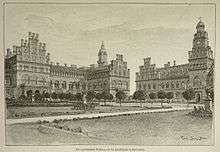 The Residence (photograph of c. 1899)
The Residence (photograph of c. 1899) Armenian church in the early 1900s.
Armenian church in the early 1900s.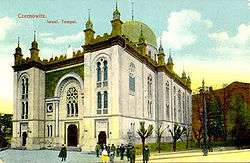 An early 20th-century postcard depicting the Czernowitz Synagogue.
An early 20th-century postcard depicting the Czernowitz Synagogue.
Demographics
| Historical population | ||
|---|---|---|
| Year | Pop. | ±% |
| 1775 | 2,300 | — |
| 1794 | 5,000 | +117.4% |
| 1832 | 11,000 | +120.0% |
| 1869 | 34,000 | +209.1% |
| 1890 | 54,200 | +59.4% |
| 1910 | 87,100 | +60.7% |
| 1930 | 112,400 | +29.0% |
| 1941 | 78,800 | −29.9% |
| 1970 | 187,000 | +137.3% |
| 1984 | 238,000 | +27.3% |
| 1989 | 295,000 | +23.9% |
| 2001 | 240,600 | −18.4% |
| 2013 (est.) | 259,897 | +8.0% |
According to the latest All-Ukrainian population census in 2001, the population of Chernivtsi was approximately 240,600 people of 65 nationalities.[4] Among them, 189,000 (79.8%) are Ukrainians; 26,700 (11.3%) Russians; 10,500 (4.4%) Romanians; 3,800 (1.6%) Moldovans; 1,400 (0.6%) Polish; 1,300 (0.6%) Jews; 2,900 (1.2%) other nationalities.[7]
Based on the last available Soviet data, the population of the city, as of 1 January 1989, was approximately 295,000 residents. Among these, there are some 172,000 Ukrainians, 46,000 Russians, 16,000 Romanians, 13,000 Moldovans, 7,000 Poles and others.
The Romanian population in Chernivtsi started decreasing rapidly after 1950. Many Romanians fled to Romania or were deported to Siberia (where most of them died), and the remaining Romanian population quickly became a minority and assimilated with the majority. Nowadays, the Romanian minority in Chernivtsi is still decreasing as a result of cultural assimilation and emigration to Romania.
Chernivtsi once had a Jewish community of over 50,000, less than a third of whom survived World War II. Romanian lawyer and reserve officer Theodor Criveanu, as well as the then city mayor Traian Popovici, supported by General Vasile Ionescu saved 19,689 Jewish people. Initially, Governor of Bukovina Corneliu Calotescu allowed only 190 Jewish people to stay, but Traian Popovici, after an incredible effort, obtained from the then dictator of Romania Marshal Ion Antonescu an allowance of 20,000.[18] After World War II, the city was a key node in the Berihah network, which helped Jews to emigrate to the then Mandate Palestine from the difficult conditions after the War. Following the collapse of the Soviet Union in 1991, the majority of the remaining Jewish population emigrated to Israel and the United States. A famous member of this latter emigration is the actress Mila Kunis.[19]
Chernivtsi was inhabited by Ukrainians, Romanians, Poles, Ruthenians, Jews, Roma, and Germans. During its affiliation with the Austro-Hungarian monarchy, Chernivtsi enjoyed prosperity and culture as the capital of the Bukovina crown land. After the World War II, the Shoah and Porajmos, and the resettlement and expulsion of the whole ethnic groups, including Germans and Romanians, this status was diminished. Today, the Ukrainians are the dominant population group.
Chernivtsi's change in demographic diversity is demonstrated by the following population statistics. Once, Romanians and Ukrainians formed the majority of the population. However, after 1870, Yiddish- or German-speaking Jews surpassed the Romanians as the largest population group of the town. After 1880, the Ukrainians surpassed the Romanians as the second largest population group.
| Jews in Chernivtsi according to Austrian-Hungarian Census[20] | |||||||
| Year | total pop. | Jews | % Jews | ||||
|---|---|---|---|---|---|---|---|
| 1857 | ca. 22,000 | 4,678 | 21.6% | ||||
| 1869 | ca. 34,000 | 9,552 | 28.2% | ||||
| 1880 | ca. 46,000 | 14,449 | 31.7% | ||||
| 1890 | ca. 54,000 | 17,359 | 32.0% | ||||
| 1900 | ca. 68,000 | 21,587 | 31.9% | ||||
| 1910 | ca. 87,000 | 28,613 | 32.8% | ||||
| Chernivtsi (City) | Chernivtsi (Suburbs) | |||
|---|---|---|---|---|
| Year | Romanians | Ukrainians | Romanians | Ukrainians |
| 1860 | 9,177 | 4,133 | 20,068 | 6,645 |
| 1870 | 5,999 | 5,831 | 28,315 | 35,011 |
| 1880 | 6,431 | 8,232 | 8,887 | 23,051 |
| 1890 | 7,624 | 10,385 | 11,433 | 34,067 |
| 1900 | 9,400 | 13,030 | 13,252 | 25,476 |
| 1910 | 13,440 | 15,254 | 18,060 | 22,351 |
Culture
Architecture
There are many places which attract citizens of Chernivtsi and the visitors: Drama Theatre, Regional Philharmonic Society, Organ and Chamber Music Hall, puppet-theatre, Museum of Local Lore, History and Economy, Museum of Fine Arts, Bukovynian Diaspora Museum, Museum of Folk Architecture and Way of Life, memorial museums of writers, the Central Palace of Culture.

The city of Chernivtsi has a lot of architecturally important buildings. Many historic buildings have been preserved, especially within the city's center. However, after years of disrepair and neglect, the buildings are in need of major restoration.
As Chernivtsi was part of the Austro-Hungarian Empire, it was closely related to the empire's culture, including architecture. Main architectural styles present within the city include Vienna Secession and Neoclassicism, Baroque, late Gothic architecture, and fragments of traditional Moldavian and Hungarian architecture, Byzantine architecture as well as Cubism.[21] During the Interwar Romanian administration, a great number of buildings in the Neo-Romanian and Art Deco architectural styles were also built.The city is sometimes dubbed Little Vienna, because its architecture is reminiscent of the Austro-Hungarian capital Vienna.[1][2]

The main architectural attractions of the city include: the Chernivtsi Drama Theater (1905); the Chernivtsi University—UNESCO World Heritage Site (1882); the Regional Museum of Fine Arts—the former savings bank (1900); the Regional Council—former Palace of Justice (1906); and the Chernivtsi Palace of Culture—former Jewish National House (1908); among many others. The magnificent Moorish Revival Czernowitz Synagogue was heavily damaged by fire in 1941, the walls were used to create the "Chernivtsi" movie theater.
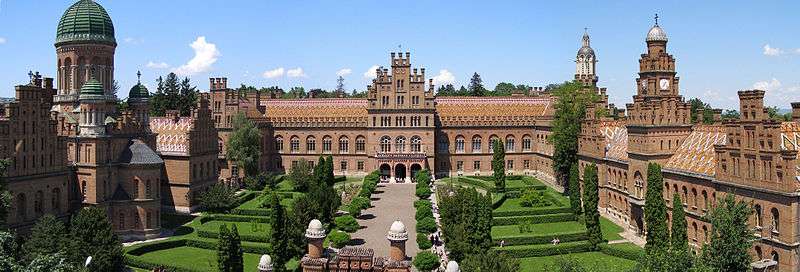
The Czech architect Josef Hlávka designed, in 1864–1882, the buildings that currently house the Chernivtsi State University. They were originally the residence of the Bukovinian and Dalmatian Metropolitans. The Romanesque and Byzantine architecture is embellished with motifs of Ukrainian folk art; for example, the tile roof patterns duplicate the geometric designs of traditional Ukrainian embroidery.
Polish House in Chernivtsi
The history of Polish community in Chernivtsi dates back to the late 18th century, when authorities of the Habsburg Empire encouraged Poles to move to Bucovina. By mid-19th century, several Polish organizations existed in the city, including Bratnia Pomoc and Czytelnia Polska. On initiative of publishers of the Gazeta Polska daily newspaper, collection of money for the construction of Polish House was initiated. In early 20th century, two Polish activists, doctor Tadeusz Mischke and judge Jakub Simonowicz purchased a house. In 1904, its expansion was initiated. It was carried out by architect Franciszek Skowron, interior decorator Konrad Górecki and sculptors from Zakopane, Skwarnicki and Gerasimowicz. The expansion was completed in 1905, and Polish House operated until World War Two.
In 1945, Soviet authorities opened here a cinema, later a music school. Currently, the complex houses Adam Mickiewicz Association of Polish Culture.
Apart from Polish House, Chernivtsi also has German, Romanian and Jewish Houses.
Education
- Chernivtsi University
- Bukovinian State Medical University
- Chernivtsi Trade-Economics Institute of the Kyiv National University of Trade and Economics
Sports
The most popular kinds of sports in Chernivtsi include archery, judo, field hockey, karate, power-lifting and orienteering.[22] Chernivtsi's baseball, hockey, and football clubs (FC Bukovyna Chernivtsi) are participants of the Ukrainian national championships.
Chernivtsi has a large number of sports establishments and facilities, including 5 stadiums, 186 sports grounds, 2 tennis courts, 11 football fields, 5 skating rinks, 21 shooting galleries, 3 swimming pools, 69 gyms, 62 gyms with special training equipment and an international motorcycle racing track.[22]
Over 7,950 inhabitants are members of sport clubs within the city, and more than 50,000 people participate in various sport activities.[22] Currently, 8 sportsmen from the city are the members of national teams and 12 are members of national youth teams.[22] 3 athletes from Chernivtsi were prize-winners in various world tournaments, 2 were winners of European and 42 of national championships in 2002.[22]
Chernivtsi has been host to the Sidecross World Championship a number of times,[23] most recently in June 2010.[24]
Transport
Rail
Chernivtsi–Berehomet line | |||||||||||||||||||||||||||||||||||||||||||||||||||||||||||||||||||||||||||||||||||||||||||||||||||||||||||||||||||||||||||||||||||||||||||||||||||||||||||||||||||||||||||||||||||||||||||||||||||||||||||||||||||||||||
|---|---|---|---|---|---|---|---|---|---|---|---|---|---|---|---|---|---|---|---|---|---|---|---|---|---|---|---|---|---|---|---|---|---|---|---|---|---|---|---|---|---|---|---|---|---|---|---|---|---|---|---|---|---|---|---|---|---|---|---|---|---|---|---|---|---|---|---|---|---|---|---|---|---|---|---|---|---|---|---|---|---|---|---|---|---|---|---|---|---|---|---|---|---|---|---|---|---|---|---|---|---|---|---|---|---|---|---|---|---|---|---|---|---|---|---|---|---|---|---|---|---|---|---|---|---|---|---|---|---|---|---|---|---|---|---|---|---|---|---|---|---|---|---|---|---|---|---|---|---|---|---|---|---|---|---|---|---|---|---|---|---|---|---|---|---|---|---|---|---|---|---|---|---|---|---|---|---|---|---|---|---|---|---|---|---|---|---|---|---|---|---|---|---|---|---|---|---|---|---|---|---|---|---|---|---|---|---|---|---|---|---|---|---|---|---|---|---|
Legend
| |||||||||||||||||||||||||||||||||||||||||||||||||||||||||||||||||||||||||||||||||||||||||||||||||||||||||||||||||||||||||||||||||||||||||||||||||||||||||||||||||||||||||||||||||||||||||||||||||||||||||||||||||||||||||
Air
Chernivtsi is served by the Chernivtsi International Airport (CWC) located south of the city centre.
International relations
Twin towns—Sister cities
Chernivtsi is twinned with:
| Country | City/Town | County / District / Region / State | |||
|---|---|---|---|---|---|
| |
Austria | |
Klagenfurt | |
Carinthia |
| |
Canada | Saskatoon | |
Saskatchewan | |
| |
Israel | |
Nazareth Illit | Northern District | |
| |
Poland | |
Konin | |
Konin County |
| |
Romania | |
Suceava | |
Suceava County, Bucovina |
| |
Romania | |
Iași | |
Iași County, Moldavia |
| |
Romania | |
Timișoara | |
Timiș County, Banat |
| |
United States | Salt Lake City | |
Utah | |
In February 2016 the Chernivtsi city council terminated its twinned relations with the Russian cities Bryansk and Podolsk due to the Ukrainian crisis.[25][26]
Notable people
Natives
- Sofia Vicoveanca originally Sofia Fusa casat. Micu (1941-) Romanian singer of popular music from the Bucovina region
- Radu Grigorovici (1911–2008) Romanian physicist
- Aharon Appelfeld (b. 1932), a Jewish writer
- Ninon Ausländer (1895–1966), art historian and wife of Hermann Hesse
- Rose Ausländer (1901–1988), a Jewish German-language writer
- Elyakim Badian (1925–2000), Israeli politician
- Irina Barash (b. 1977), Jewish-American physician
- Mara Beller (born "Barukh); 1945-2004, Jewish historian and philosopher
- Charles K. Bliss (1897–1985), inventor of Blissymbolics
- Ion Bostan (1914–1992), a Romanian film director
- Octav Botnar (1913–1998), a Romanian businessman, philanthropist, billionaire
- Josef Burg, (1912–2009), last Yiddish poet in Czernowitz
- Paul Celan (born Antschel; 1920–1970), Romanian-Jewish, German language poet and translator
- Erwin Chargaff (1905–2002), a Jewish biochemist
- Eugen Ehrlich (1862–1922), a Jewish jurist
- Natalia Fedner, Fashion Designer
- Moysey Fishbeyn (1947–), a Ukrainian poet
- Dmytro Hnatyuk (1925–2016), a Ukrainian baritone opera singer
- Raimund Friedrich Kaindl, (1866–1930) historian of Bukovina, professor at Franz-Josef University, Czernowitz (now the University of Chernivtsi)
- Frederick John Kiesler (1890–1965), a theater designer, artist, theoretician and architect
- Ruth Klieger Aliav (born Polishuk; 1914–1979), a female Romanian-Israeli Jewish activist
- Sam Kogan (1946–2004), stage director, actor and founding principal of the Academy of the Science of Acting and Directing in London
- Ani Lorak (1978–), Ukrainian singer, songwriter, actress
- Eusebius Mandyczewski (1857–1929), a Ukrainian musicologist, composer (Greek Orthodox)
- Itzik Manger (1901–1969), Jewish writer, who wrote in Yiddish
- Georg Marco (1863–1923), Austrian chess-player and author
- Carol Miculi (1821–1892), Romanian (and Polish, Ukrainian, Armenian ancestry) pianist and composer, born in Lemberg, student of Frédéric Chopin
- Jan Mikulicz-Radecki (1850–1905), a Polish surgeon
- Dan Pagis (1930–1986), an Israeli writer
- Anton Pawlowski (1830–1901), Imperial and Royal Senior Government Building Officer, Commander of the Royal Romanian Order of the Crown, Honorary Master of the Alemannia Student (Duelling) Corps, etc.
- Traian Popovici (1892–1946), a Romanian lawyer, mayor of this city, and a Righteous Among the Nations (Chasidey Umoth HaOlam)
- Iacob Pistiner, lawyer and Member of the Romanian Parliament in the interwar years
- Bernard Reder, sculptor
- Markus Reiner (1886–1976), one of the founders of rheology
- Gregor von Rezzori (1914–1998), a German-language writer of Sicilian-Austrian origin
- Ludwig Rottenberg (1864–1932), conductor and composer
- Lev Shekhtman (1951–), Russian/American theater director and actor
- Ze'ev Sherf (1904–1984), Israeli Minister of Finance
- Jan Tabachnyk (1945–), singer and composer
- Sidi Tal (1912–1983), singer and actress
- Stefanie von Turetzki (1868–1929) founder of the first girls' grammar school in Austria–Hungary in Czernowitz
- Viorica Ursuleac (1894–1985) Romanian opera singer (dramatic soprano)
- Roman Vlad (1919–2013) Romanian-Italian composer, pianist, and musicologist
- Sydir Vorobkevych (1836–1903) Ukrainian composer and writer
- Mariya Yaremchuk (1993-), Ukrainian singer, represented Ukraine in the Eurovision Song Contest 2014.
- Viorica Ursuleac (1894–1985) Romanian operatic soprano.
- Arseniy Yatsenyuk (1974-), Ukrainian politician
- Frederic Zelnik, an important German silent movie director-producer, was born in Czernowitz on 17 May 1885
Residents
- Moyshe Altman (1890–1981) Yiddish writer
- Hermann Bahr
- Grigore Vasiliu Birlic (1905–1970) Romanian actor
- Nathan Birnbaum
- Charles K. Bliss
- Nikolay Bogolyubov
- Erwin Chargaff
- Mihai Eminescu (1850–1889) Romanian poet, novelist and journalist
- Sextil Iosif Pușcariu (1877–1948) Romanian linguist and philologist
- Karl Emil Franzos (1848–1904), Jewish writer and publicist, grew up in Czernowitz and wrote a literary memorial of the Jewish ghetto: The Jews of Barnow
- Jacob Frank
- Constantin Isopescu-Grecul (1871–1938) Romanian jurist, politician and journalist
- George Popovici (1863–1905) Romanian agrarian politician, jurist and poet
- Grigore Nandriș (1895-1968) Romanian linguist, philologist and memoirist
- Ivan Franko
- Gala Galaction, originally Grigore Pisculescu (1879–1961), Romanian writer
- Abraham Goldfaden, active here
- Zygmunt Gorgolewski
- Ion Grămadă (1886—1917) Romanian writer, historian and journalist
- Hans Hahn
- Eudoxiu Hurmuzachi (1812-1874) Romanian historian, politician (governor of the Duchy of Bucovina) and patriot
- Alexandru (Alecu) Hurmuzachi (1823-1871) Romanian politician and publisher
- Nicolae Bălan (1882–1955) Romanian cleric, a metropolitan bishop of the Romanian Orthodox Church
- Nicolae Cotos (1883–1959) Romanian theologian
- Volodymyr Ivasyuk
- Joseph Kalmer
- Ion G. Sbiera (1836-1916) Romanian folklorist and historian
- Leonid Kravchuk
- Olha Kobylyanska
- Mila Kunis[27][28][29]
- Zvi Laron
- Anastasiya Markovich (1979–), painter
- Ivan Mykolaychuk (1941–1987)
- Miron Nicolescu (1903–1975) Romanian mathematician
- Ion Nistor (1876–1962) Romanian historian and politician
- Dimitrie Onciul (1856–1923) Romanian historian
- Iancu Flondor (1865–1924) Romanian activist who advocated Bukovina's unifion with the Kingdom of Romania
- Traian Brăileanu (1882–1947) Romanian sociologist and politician
- Maximilian Hacman (1877–1961) Romanian jurist
- Romulus Cândea (1886–1973) Romanian ecclesiastical historian
- Israel Polack
- Ciprian Porumbescu (1853–1883) Romanian composer
- Aron Pumnul (1818-1866) Romanian philologist and teacher, national and revolutionary activist
- Wilhelm Reich (1897–1957), Jewish psychoanalyst and sexologist, born in Dobrzanica, went to school in Czernowitz
- Eric Roll
- Florin Piersic (1936-) Romanian actor and TV personality
- Sofia Rotaru (1947-) Romanian-Ukrainian pop singer
- Maximilien Rubel
- Wojciech Rubinowicz
- Josef Schmidt (1904–1942) singer, actor and cantor
- Fritz von Scholz
- Joseph Schumpeter (1883–1950), economist and Minister of Finance, 1909–1911 Professor in Czernowitz
- Wilhelm Stekel (1868–1940), Jewish psychoanalyst and sexologist, born in Boiany, Bukowina, grew up in Czernowitz and attended the Gymnasium (grammar school)
- Vasile Tărâțeanu (1945-) Romanian journalist and writer
- Nazariy Yaremchuk
Gallery
See also
References
- 1 2 3 Zhytariuk, Natalia. "Bukovyna Week in Austria". Den. Retrieved 26 September 2007.
- 1 2 3 "Bukovina. The beech tree land". Ukraine Cognita. Archived from the original on 28 July 2011. Retrieved 26 September 2007.
- ↑ (Ukrainian) Kaspruk win in Chernivtsi
- 1 2 "About number and composition population of CHERNIVTSI REGION by data All-Ukrainian Population Census '2001". Archived from the original on 26 December 2005. Retrieved 2012-12-05.
- ↑ "Trypillya – a culture that was contemporaneous with Ancient Egypt and Mesopotamia". Welcome to Ukraine. Retrieved 27 September 2007.
- ↑ "City of Chernivtsi – History". The Komkon Site. Archived from the original on 27 September 2007. Retrieved 25 September 2007.
- 1 2 3 4 "History". Chernivtsi City Official Site. Retrieved 25 September 2007.
- ↑ (Romanian) Cetatea Ţeţina – Cernăuţi, Astra, 3 (13), 1998
- ↑ (Romanian)Cernăuţi-600 de ani de atestare documentară internă, Astra, 4 (54), 2008, p.3
- ↑ Geographical Etymology - a dictionary of place-names giving their derivations, Christina Blackie (1887)
- ↑ "Chernivtsi". Ukrainian heraldry. Retrieved 25 September 2007.
- ↑ Ion Lihaciu, Czernowitz 1848–1948. Das kulturelle Leben einer Provinzmetropole, Parthenon Verlag, Kaiserslautern und Mehlingen 2012, ISBN 978-3-942994-00-2
- 1 2 "Bukovina". Encyclopædia Britannica. Retrieved 26 September 2007.
- ↑ (Ukrainian) Chernivtsi banned signs with the word "Russia", Ukrayinska Pravda (4 April 2016)
- ↑ "Pogoda.ru.net" (in Russian). Weather and Climate (Погода и климат). May 2011. Retrieved 28 November 2015.
- ↑ "CERNOVCY Climate Normals 1961–1990". National Oceanic and Atmospheric Administration. Retrieved 17 December 2012.
- ↑ The raion was formerly named Lenin Raion. The raion was renamed in accordance with the Rivne Oblast Council's decision.
- ↑ "Righteous Among the Nations Ceremony from Romania Tomorrow". Yad Vashem. Retrieved 21 April 2009.
- ↑ Міла Куніс зіграє у трилері "Чорний лебідь", Gazeta.ua (13 August 2009) (Ukrainian)
- ↑ Ergebnisse der Volkszählungen der K. K. Statistischen Central-Kommission u.a., in: Anson Rabinbach: The Migration of Galician Jews to Vienna. Austrian History Yearbook, Volume XI, Berghahn Books/Rice University Press, Houston 1975, S. 46/47 (Table III)
- ↑ "Sport & Tourism II". Chernivtsi City Official Site. Retrieved 25 September 2007.
- 1 2 3 4 5 "Sport & Tourism". Chernivtsi City Official Site. Retrieved 25 September 2007.
- ↑ VENUES USED IN GP 1971–2005 The John Davy Pages, accessed: 2 November 2009
- ↑ FIM Sidecarcross World Championship—2010 Calendar Archived 12 August 2011 at the Wayback Machine. FIM website, accessed: 30 October 2009
- ↑ (Ukrainian) Chernivtsi decided to terminate the relationship with twin two Russian cities, The Ukrainian Week (February 27, 2016)
- ↑ "Podolsk sister cities". Translate.google.com. Retrieved 29 April 2010.
- ↑ Ukrainian Jews Archived 3 November 2013 at the Wayback Machine., Bible Discovered
- ↑ (Ukrainian) Міла Куніс зіграє у трилері ”Чорний лебідь”, Gazeta.ua (13 August 2009)
- ↑ 'EXTRACT' STAR MILA KUNIS ON HER RUSSIAN ROOTS on YouTube
External links
| Wikivoyage has a travel guide for Chernivtsi. |
| Wikimedia Commons has media related to Chernivtsi. |
| Look up chernivtsi in Wiktionary, the free dictionary. |
| Wikisource has the text of the 1905 New International Encyclopedia article Czernowitz. |
- Information Portal Chernivtsi
- "Main Page". Chernivtsi City Official Site/English. Retrieved 12 April 2010.
- "Main Page". Chernivtsi City Official Site/English(mirror). Retrieved 12 December 2009.
- Chernivtsi article by Vladislav Davidzon Tablet Magazine
- "Per le vie di Chernivtsi, città dei sogni yiddish" article by Tommy Cappellini Corriere del Ticino (Italian)
- Chernivtsi Photos


